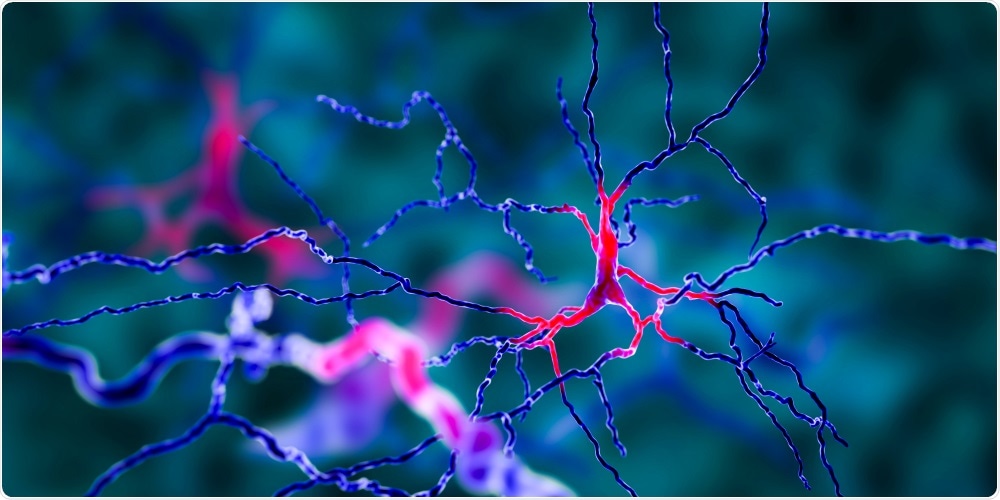Scientists from DZNE revealed that certain viral diseases can contribute to neurodegeneration. Their analysis depends on lab examinations where they could demonstrate that some viral molecules enable intercellular spreading of protein aggregates that are characteristic of brain diseases like Alzheimer’s.

Image Credit: Kateryna Kon/Shutterstock.com
The observations might offer clues on the contribution of acute or chronic viral infections to neurodegeneration. The study was published in the scientific journal Nature Communications.
Aggregates of misfolded proteins, found in alleged prion diseases like Creutzfeldt-Jakob disease, can transfer from one cell to another. They pass on their abnormal shape to proteins of a similar kind, resulting in the spreading of disease across the brain. A similar phenomenon is considered for Parkinson’s and Alzheimer’s disease, which also shows assemblies of misfolded proteins.
Transfer of aggregates can involve direct cell-to-cell contact, the release of “naked” aggregates into extracellular space, or packaging in vesicles, which are small bubbles enclosed by a lipid envelope secreted for communication between cells.
The precise mechanisms of transmission are unknown. However, it is an obvious guess, that aggregate exchange by both direct cell contact and via vesicles depends on ligand-receptor interactions. This is because, in both scenarios, membranes need to make contact and fuse. This is facilitated when ligands are present that bind to receptors on the cell surface and then cause the two membranes to fuse.”
Ina Vorberg, Professor, University of Bonn
Vorberg is a research group leader at DZNE’s Bonn site.
Experiments with cell cultures
Based on the hypothesis, Vorberg’s team, with assistance from DZNE co-workers in Munich and Tübingen and also Belgian scientists, carried out a comprehensive series of research with various cell cultures. The researchers analyzed the intercellular transmission of either prions or aggregates of tau proteins, as they appear in the same form in Alzheimer’s disease or prion diseases and other “tauopathies.”
Imitating the results of viral infection, the scientists triggered cells to produce viral proteins that intervene in target cell binding and membrane fusion. Two proteins were selected as major examples—vesicular stomatitis virus glycoprotein VSV-G, which is seen in a pathogen that affects cattle and other animals, and SARS-CoV-2 spike protein S, which occurs from the virus inducing COVID-19.
Furthermore, cells expressed receptors for these viral proteins, known as the LDL receptor family, which functions as docking ports for VSV-G, and human ACE2, the receptor for the spike protein.
Ligands facilitate aggregate spreading
We could show that the viral proteins are incorporated both into the cellular membrane and into the extracellular vesicles. Their presence increased protein aggregate spreading between cells, both by direct cell contact or by extracellular vesicles.”
Ina Vorberg, Professor, University of Bonn
“The viral ligands mediated an effective transfer of aggregates into recipient cells, where they induced new aggregates. The ligands act like keys that unlock the recipient cells and thus sneak in the dangerous cargo,” added Vorberg.
“Certainly, our cellular models do not replicate the many aspects of the brain with its very specialized cell types. However, independent of the tested cell type producing the pathologic aggregates, the presence of viral ligands clearly increased the spreading of misfolded proteins to other cells,” stated Vorberg.
Vorberg adds, “All in all, our data suggests that viral ligand-receptor interactions can in principle affect the transmission of pathologic proteins. This is a novel finding.”
Potential effects on neurodegeneration
The brains of patients suffering from neurodegenerative diseases sometimes contain certain viruses. They are suspected to cause inflammation or to have a toxic effect, thus accelerating neurodegeneration. However, viral proteins could also act differently: They could increase the intercellular spreading of protein aggregates already ongoing in neurodegenerative diseases like Alzheimer’s.”
Ina Vorberg, Professor, University of Bonn
Vorberg concludes by saying, “Of course, this needs further studies with neurotropic viruses. Clearly, the impact of viral infections on neurodegenerative diseases deserves in-depth investigation.”
Source:
Journal reference:
Liu, S., et al. (2021) Highly efficient intercellular spreading of protein misfolding mediated by viral ligand-receptor interactions. Nature Communications. doi.org/10.1038/s41467-021-25855-2.